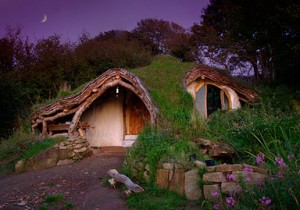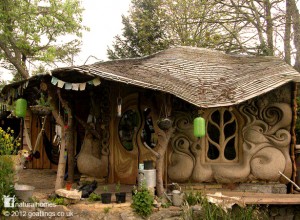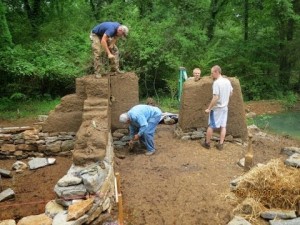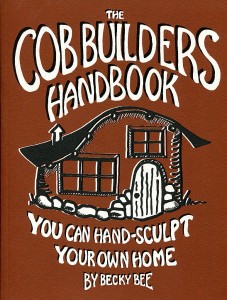Field Guide to an Art World
Cob- Not Just a Hobbit House
Introduction to Cob
The art world I’m choosing to explore is an alternative type of building material called cob. Some people may be familiar with “cob cottages”, including the famous “Hobbit House”, but cob can really be used to form many structures and buildings such as: garden walls, stoves, benches or sheds. Cob is made from a mixture of sand, clay, and straw in a (somewhat) specific ratio to form a home building material similar to adobe. It can be freely sculpted much like clay to create a living space hand built and truly unique. Stairs, benches, shelves and even beds sculpture directly into the walls of cob homes. Cob buildings can be large or small, one or two stories, and even have a live plant roof. I’m choosing to explore this art world because I’ve been really interested in cob as an alternative building material for many years and hope to be able to design and craft my own home someday, from it. I think I am drawn to the idea of being directly involved in creating your own home, other than planning and design. Being a ceramicist, I’m a very process oriented and tactile person, and the idea of physically sculpting my home from the foundation to the roof is exciting!
Why Cob?
Due to the nature of ingredients (clay, sand, and straw), cob is an extremely low cost and sustainable building material. Many builders prefer to keep with the inexpensive and sustainable style of building and prefer to use reclaimed doors, windows, and anything else they can salvage. This makes it accessible to people that might not be satisfied with a “cookie cutter” type of home or those working with a smaller budget. With alternative building materials like cob, straw bale, cored wood, rammed earth, and even trash becoming more popular and acceptable, this could change social conventions and offer perspectives on sustainable living to new audiences. It is also a very community oriented building experience that lends itself to building parties and workshops. The malleability and free flowing nature of the material has so much artistic potential that I’m amazed more people haven’t been exposed to it yet! I’ve seen sculpted vines, swirls, undulations, trees, geometric designs, and whimsical asymmetry, all built permanently into the structure. I visited a cob greenhouse in Pennsylvania that had different colored glass pieces inlaid directly into the cob wall that created a mosaic, stained glass effect when the sunlight hit it.
I’ve already done a good amount of research on this topic, but it’s something I’m passionate about sharing since most people don’t know anything about cob. Also, I’m hoping with a little more research, I’ll actually be able to make a batch of cob—at least to make test bricks, just to get a feel for the material and see what ratio of materials seems to work best. The material-cob, mixed from the three ingredients is inexpensive (compared to traditional home building ones) and fairly straightforward to create. One can mix the ingredients by laying them out on a big tarp, in the proper ratio, and just stomp and squish them together or use a commercial mixer to assist in this laborious process.
After the materials are mixed and the foundation is laid, the process of plopping and packing cob to make the walls begins. This all can take quite a bit of time, so having friends, family, workshops, volunteers, or anyone else to come out to learn and participate is usually commonplace. Unlike most conventional home building experiences, working one-on-one with an architect or builder, most often, many people come together to lend a hand in the building process. The collective nature of cob building brings people from all communities and age groups together to create.
There is an abundance of cob building resources on the internet, including videos showing various types of structures built, how to mix the materials, how to sculpt the walls, and people having cob parties and just stomping around in the mud together. The internet also provides a rich archive of photographs showing beautiful cob structures along with many how-to articles, diagrams, and frequently asked questions. I personally have a couple of books on cob I’ll probably reference or copy images to post here. Ideally, I’d like to set up an interview with a local cob building company or contractor to dig deeper regarding types of participants and their experiences. With many blogs, workshops, and companies operating out of the Pacific Northwest, Oregon is actually a great place to research and learn more about cob as a form of artistic expression and building material.




